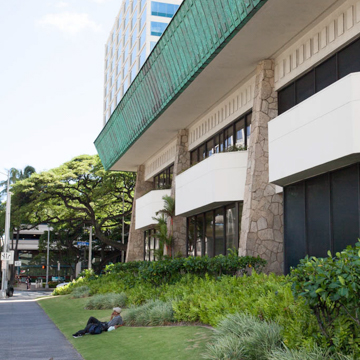The three-story, coral-veneered bank is a distinctive contribution to the ongoing conversation on appropriate regional design for Hawaii. At its opening, the Honolulu Star Bulletin found that the building “avoided the ‘big city' look with a Hawaiian appearance.” Modern in design, yet Hawaiian in texture and feeling, the building establishes an intense energy between its various elements. The soaring, coral buttresses interact with the horizontal yet upward-rising copper frieze and cornice to establish a strong play of projection and recession with the fenestration and concrete second-story balcony planters. This dynamic composition is enhanced by the bold natural colors of the building's materials. The bank is set back from the street, allowing the softening presence of ground vegetation from which steps lead up to the off-center entrance. The interior was reconfigured in 2002 when marble floors and walls were added, but the coral columns and copper-paneled mezzanine were retained, bringing inside a memory of the outside.
You are here
First Hawaiian Bank
If SAH Archipedia has been useful to you, please consider supporting it.
SAH Archipedia tells the story of the United States through its buildings, landscapes, and cities. This freely available resource empowers the public with authoritative knowledge that deepens their understanding and appreciation of the built environment. But the Society of Architectural Historians, which created SAH Archipedia with University of Virginia Press, needs your support to maintain the high-caliber research, writing, photography, cartography, editing, design, and programming that make SAH Archipedia a trusted online resource available to all who value the history of place, heritage tourism, and learning.






















